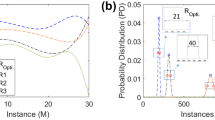Abstract
Counting data from the triple-to-double coincidence ratio (TDCR) method are by their nature highly correlated. In the general case of unequal phototube detection efficiencies, the highly correlated nature of the data combined with the need to apply methods to solve a system of equations makes proper uncertainty analysis difficult. Removing the correlations from the data prior to analysis may assist in this endeavor. This paper describes the de-correlation of TDCR data by the application of a particular linear transform, the Mahalanobis transform. A programming example in MATLAB is given and a practical example of the use of this technique in the analysis of TDCR data is presented.



Similar content being viewed by others
Notes
Certain commercial equipment, instruments, or materials are identified in this paper to foster understanding. Such identification does not imply recommendation by the National Institute of Standards and Technology, nor does it imply that the materials or equipment identified are necessarily the best available for the purpose.
References
Broda R, Cassette P, Kossert K (2007) Radionuclide metrology using liquid scintillation counting. Metrologia 44:36–52
Kossert K, Broda R, Cassette P, Ratel G, Zimmerman BE (2015) Uncertainty determination for activity measurements by means of the TDCR method and the CIEMAT/NIST efficiency tracing technique. Metrologia 52:S172–S190
Kessy A, Lewin A, Strimmer K (2017) Optimal whitening and decorrelation. Am Stat. doi:10.1080/00031305.2016.1277159
Mahalanobis PC (1936) On the generalized distance in statistics. Proc Natl Inst Sci India 2(1):49–55
Vidakovic B (2011) Statistics for bioengineering sciences with MATLAB and WinBUGS support. Springer, Berlin
MATLAB R2016b (2016) MathWorks, Natick
The R Environment, The R-Foundation (2017) https://www.r-project.org/foundation/. Accessed 25 May 2017
Mathematica, Wolfram Research, Champaign
Ypma T (1995) The historical development of the Newton–Raphson method. SIAM Rev 37(4):531–551
Author information
Authors and Affiliations
Corresponding author
Rights and permissions
About this article
Cite this article
Zimmerman, B.E. Correlation in the application of the triple-to-double coincidence ratio method with unequal photomultiplier tube efficiencies. J Radioanal Nucl Chem 314, 605–609 (2017). https://doi.org/10.1007/s10967-017-5429-1
Received:
Published:
Issue Date:
DOI: https://doi.org/10.1007/s10967-017-5429-1




